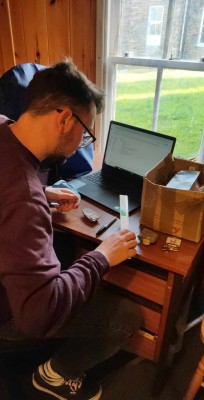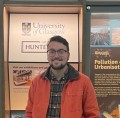I have visited Stromness almost every year of my life and yet I had never visited the Museum until the summer of 2023. My first visit came shortly before I began volunteering there, and I had expected something very different than the breadth and diversity of material and stories that I found. I quickly knew this was the kind of place I would love to gain experience of museum work and expand my knowledge and skillset. I began communicating with Katy Firth, the Museum’s Climate Change Exhibitions and Outreach Officer, and a few weeks later I was on the train north, ready to start the following day.
My month of volunteering began in a whirlwind with the Orkney International Science Festival and helping with four days of school workshops and classroom visits. These were a fantastic chance to jump in at the deep-end and make a contribution towards local communities. Day One began with a crash course in Ocean Sunfish, an example of which is one of the oldest specimens in the museum. Twenty minutes later the first class had arrived, and I was busy demonstrating the size of the largest ever sunfish and how to play ‘Pin the Fins on the Sunfish’. This trend continued over the following days as I familiarised myself with new information and immediately helped to convey it to a new group of school pupils. I had not anticipated that I would be learning about Sunfish, photosynthesis, plankton, and polarising light filters, but if my time at the Stromness Museum has taught me anything, it is to expect the unexpected.
With the 2023 edition of the Orkney International Science Festival coming to an end, my attention was turned to the original impetus of my volunteering: The Ted Kellock Microscope Project. During my initial conversations with Katy, we had established that the project to digitise and catalogue the geological slide collection of Ted Kellock would comprise the majority of my work at the Museum. Once again this took me by surprise. Not only did this give me valuable experience of digitising and transcribing (both large parts of modern museum collections practice) but I also thoroughly enjoyed it and found myself learning and becoming more interested in geology, a subject I’d never been previously drawn to.
Meanwhile, I was undertaking another venture. A former curator of the Museum in the mid-twentieth century had left several tins of objects to the Museum, and I was given the opportunity to take inventory of these donations. When I first sat down to dive into the selection of mysterious old biscuit tins, I felt like a child on Christmas Day, and I was not disappointed. I could not have imagined how varied and fascinating this donation would be. These objects could only be described as weird and wonderful, ranging from natural history specimens like giant hollow bird eggs, seal teeth and whiskers, a dried seahorse, whale baleen, and several sets of animal jaws, to archaeological material, like pottery from Egypt, polished stones, seashell money, and more axe and arrow heads than I could count. It was a joy to examine and research these objects and I felt very privileged to do so.
The Stromness Museum is a real gem, containing a greater breadth of objects and stories than would normally be expected of a small, independent museum. My time volunteering there was incredibly enjoyable and informative, and I would highly recommend the Stromness Museum to visitors and volunteers alike.
All at Stromness Museum would like to thank Ruairidh for the time he spent volunteering with us and we hope to see him again soon.






